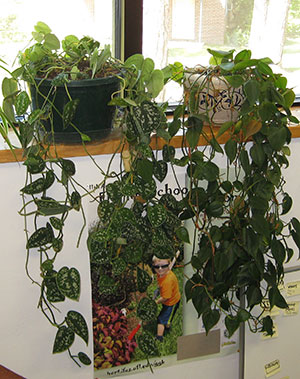Heartleaf Philodendron
If you’re looking for a fool-proof house plant, you couldn’t do much better than a heartleaf philodendron.

These easy-growing foliage plants thrive with indirect light and very little maintenance.
Heartleaf philodendrons are often grown in hanging baskets which allow the thin stems and heart-shaped leaves to beautifully spill out of their container.
Characteristics
Heartleaf philodendron (Philodendron hederaceum var. oxycardium) are a vining type of philodendron with dark green heart-shaped leaves, generally 2–4 inches in size.
Grown in a container indoors, heart-leaf philodendrons can be displayed as a specimen plant on a table, shelf, or wall bracket, where the long, trailing vines of the plant can have room to spread. They can also be trained to climb up a screen, trellis, pole, or a bark board.
For those in warmer climates (USDA hardiness zones 10B through 11) heartleaf philodendron can also be grown outside for completely different results. As a groundcover, heart-leaf philodendron will quickly provide a dark green carpet in shady areas. When allowed to grow up trees or other vertical supports leaves can grow quite large, reaching 12 inches or more in length. Indoors, the growth of your heartleaf philodendron will be dependent on the height of their support, training, and pruning.
If you have pets in the house, make sure your heart-leaf philodendron is place where curious paws will not be able to get to it. Philodendrons are toxic to pets; chewing on plants can cause oral pain, drooling, foaming, vomiting, and moderate to severe swelling of the lips, tongue, oral cavity, and upper airway. People can also have mild allergic reactions to the sap, resulting in an itchy rash.
Planting and Care
Philodendrons are versatile and hardy plants, and are generally easy to care for in your home. Heartleaf philodendrons enjoy bright diffuse light, but will tolerate a range of lighting conditions from diffused light to shade; just avoid direct sunlight as this can burn the leaves.
One of the reasons heart-leaf philodendron does so well indoors is that it prefers the same temperature range as we do; temperatures below 50°F are too cool for this particular plant.
Water your philodendron when the top inch of soil becomes dry to the touch. Using a light weight, well-drained potting media will help ensure that your plant does not become too wet or water logged. While philodendrons prefer high humidity, they are capable of tolerating the low humidity levels of a typical household. Fertilize your philodendron every 3-4 months to keep your plant looking great.
While philodendrons are easy to maintain, too much water or too little light can cause yellowing leaves, and too much fertilizer can cause the leaf tips of your plant to brown and curl. Although generally pest free, they have been known to be infested by aphids, mealy bugs, scales, and spidermites.
Heartleaf philodendron is also very easy to propagate; you can start new plants for yourself or to share by planting short stem cuttings in clean potting media. This versatile, easy-to-grow plant is a great way for both novices and seasoned gardeners to bring the outdoors in.
Also on Gardening Solutions
- Houseplants for the Forgetful Gardener
- Houseplants That Clean the Air
- Hybrid Philodendrons
- Philodendrons
- Versatile Vines
